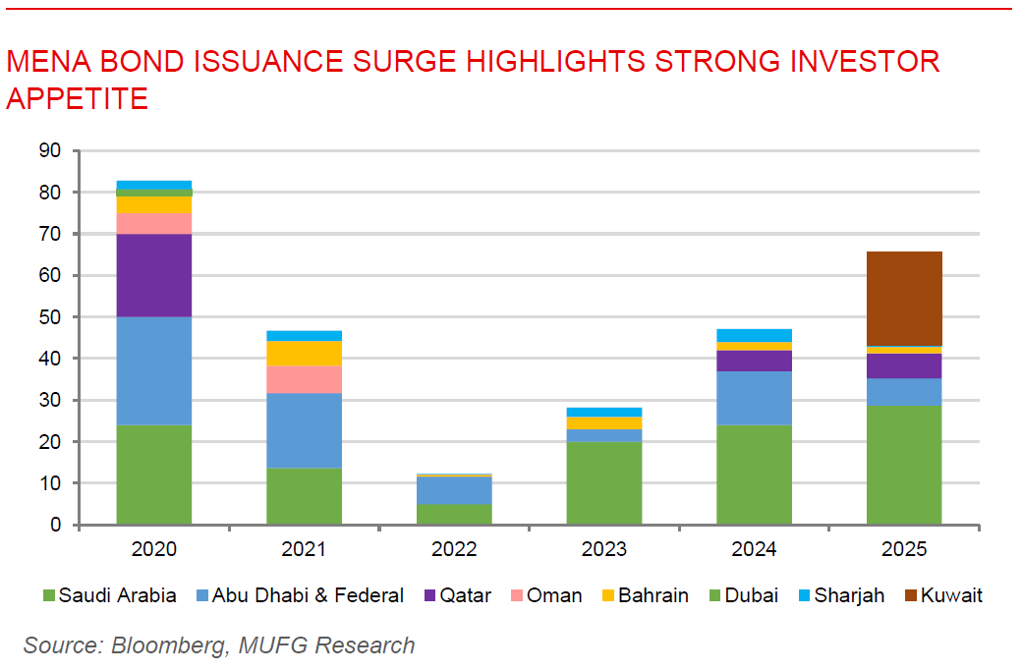To read the full report, please download the PDF above.
Middle East Daily
SOOJIN KIM
Research Analyst
DIFC Branch – Dubai
T: +44(4)387 5031
E: soojin.kim@ae.mufg.jp
MUFG Bank, Ltd. and MUFG Securities plc
A member of MUFG, a global financial group
Middle East Daily
COMMODITIES / ENERGY
Oil steadies as market awaits OPEC+ talks and US shutdown deadline passes. Oil prices stabilised after a two-day slide, with Brent trading near USD66/b and WTI above USD62/b, as traders weighed speculation that OPEC+ could accelerate planned supply hikes when members meet this weekend, though the group denied any such proposal. The market remains pressured by expectations of oversupply following recent output increases, with the IEA forecasting a record surplus next year despite Chinese stockpiling providing some support. September marked a second straight monthly drop for crude, reflecting persistent supply concerns. Meanwhile, investors are also watching the US political standoff as the US government shutdown begins, which has weighed on equities, while a mixed industry report showed crude stockpiles fell by 3.7 million barrels even as gasoline and distillate inventories rose.
Gold hit record high as shutdown fears and Fed uncertainty boost demand. Gold surged to a fresh record of USD3,875/oz, marking its fourth consecutive daily gain, as investors turned to safe-haven assets amid the US government shutdown. The deadlock in Washington has halted federal operations for the first time in nearly seven years and could delay key economic data, including Friday’s payrolls report, which markets closely watch for policy signals. The Fed’s resumption of interest rate cuts has added momentum, though uncertainty lingers as Boston Fed President Susan Collins signalled more reductions may be warranted, while Vice Chair Philip Jefferson warned of a cooling labour market alongside persistent inflation pressures. This policy divergence has only reinforced gold’s appeal as a hedge against both economic and monetary instability.
MIDDLE EAST - CREDIT TRADING
End of day comment – 30 September 2025. Relatively quiet month and quarter end. Flows picked up in the afternoon but stayed comparably subdued. Buyers and sellers equalled each other out. What remains though is the fact that dealers are cutting out of positions. ADGB saw continued 'rationalisation' of the curve post new issue, the 3y feels heavy and now widened 10bp from new issue level. That also led to selling of the outstanding 3/5y bonds, like 4.875 29s today closing -0.125pt/+5bp. The new 10y bond sees more two way interest as stands now 3bp wider from new issue. Long end remains well bid closing unch/-1bp. Activity in QATAR sovereign materially slowed as it is not part of the new issuance bonanza, long end bonds though remain bid, 46s closing +0.125pt/-2bp. Oman remains weaker, mainly driven by the belly which again closed a touch lower in cash today, 32s closing -0.125pt/+3bp. MOROC again failed to benefit from the S&P upgrade and remained little changed on close to zero activity. new issuance still dominates the secondary activity. Overnight will see Kuwait pricing its deal which could affect IG names. Overall the market still remains in balance with little price movements and spreads more a function of UST moves.
MIDDLE EAST - MACRO / MARKETS
MENA bond issuance surge highlights strong investor appetite. Bond sales in the Middle East and North Africa surged on 30 September as governments rushed to tap global markets ahead of expected us rate cuts, with Kuwait raising USD11.25bn in its first international issuance in eight years and Egypt securing USD1.5bn through sukuk to diversify funding amid its economic recovery. Demand was strong, with Kuwait’s three-, five-, and ten-year notes attracting over USD27bn in bids and pricing at no more than 50bps above Treasuries. While Egypt’s sukuk drew USD8.9bn in offers, yielding 6.375% and 7.95% for the three- and seven-year tranches. Bahrain also mandated banks for a two-tranche dollar issuance, and Algeria announced plans to raise USD2.3bn locally through Islamic bonds, a rare move for the OPEC member. Meanwhile, Saudi Arabia has already raised nearly USD20bn in global debt this year, making it one of the world’s largest emerging market issuers alongside Mexico. The wave of issuance reflects governments’ efforts to plug widening fiscal deficits caused by lower oil and gas prices, while investors continue to be drawn to high yields and narrowing risk spreads across emerging markets.
Saudi Arabia projects wider 2025 budget deficit amid oil weakness. Saudi Arabia forecasted a larger than expected budget deficit of 5.3% of GDP in 2025, up from an earlier estimate of 2.3%, as lower oil revenues and higher spending weigh on public finances. The shortfall reflects weaker oil export income and heavy expenditure tied to Vision 2030 diversification agenda, which is driving massive investments in non-oil sectors. The Finance Ministry expects deficits to narrow gradually to 3.3% in 2026 and 2.2% in 2028, with spending briefly dipping in 2026 before rising again. To finance the gap, the Kingdom has already raised nearly USD20bn in global debt this year and plans to expand borrowing and alternative financing in 2026. The economy is projected to grow 4.4% in 2025 and 4.6% in 2026, led by services and tourism.

